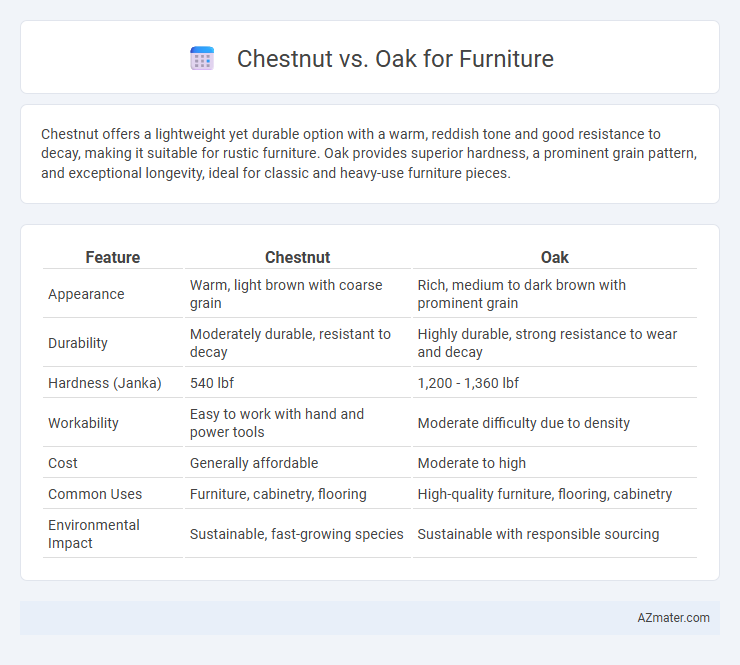Chestnut offers a lightweight yet durable option with a warm, reddish tone and good resistance to decay, making it suitable for rustic furniture. Oak provides superior hardness, a prominent grain pattern, and exceptional longevity, ideal for classic and heavy-use furniture pieces.
Table of Comparison
| Feature | Chestnut | Oak |
|---|---|---|
| Appearance | Warm, light brown with coarse grain | Rich, medium to dark brown with prominent grain |
| Durability | Moderately durable, resistant to decay | Highly durable, strong resistance to wear and decay |
| Hardness (Janka) | 540 lbf | 1,200 - 1,360 lbf |
| Workability | Easy to work with hand and power tools | Moderate difficulty due to density |
| Cost | Generally affordable | Moderate to high |
| Common Uses | Furniture, cabinetry, flooring | High-quality furniture, flooring, cabinetry |
| Environmental Impact | Sustainable, fast-growing species | Sustainable with responsible sourcing |
Introduction to Chestnut and Oak in Furniture Making
Chestnut and oak are two prominent hardwoods favored in furniture making for their durability and distinct grain patterns. Chestnut offers a lightweight yet sturdy option with a warm, reddish-brown hue that develops a rich patina over time. Oak, known for its exceptional strength and prominent grain texture, provides a timeless, classic aesthetic highly resistant to wear and moisture.
Historical Use of Chestnut and Oak Wood
Chestnut wood was historically favored in furniture-making during the 18th and 19th centuries for its durability, workability, and resistance to decay, especially in colonial America. Oak wood, widely used in European and American furniture since the Middle Ages, is renowned for its strength, distinctive grain patterns, and longevity, making it a staple in crafting heirloom-quality pieces. Both woods have played significant roles in traditional craftsmanship, with chestnut prized for its lightness and oak valued for its robust hardness and structural integrity.
Appearance and Grain Patterns
Chestnut wood features warm, reddish-brown tones with a coarse, straight grain that creates a rustic and natural appearance ideal for casual, country-style furniture. Oak showcases a broader range of colors from light tan to medium brown with pronounced, intricate grain patterns, including swirls and rays, giving furniture a more elegant and traditional look. The distinctive texture of oak enhances its visual depth, while chestnut's uniform grain offers a simpler, more consistent aesthetic.
Durability and Hardness Comparison
Chestnut wood exhibits moderate hardness with a Janka rating of approximately 540, making it softer and less resistant to dents compared to oak. Oak, particularly white oak, boasts a higher Janka hardness of about 1360, providing superior durability and resistance to wear and impact in furniture applications. Furniture crafted from oak typically offers enhanced longevity and robustness, whereas chestnut is better suited for lighter-use pieces due to its comparatively lower hardness and durability.
Workability and Finishing Properties
Chestnut offers excellent workability due to its moderate density and straight grain, making it easier to saw, plane, and carve compared to oak. Oak's higher density and more complex grain structure provide greater durability but can pose challenges in machining and require sharper tools for clean cuts. Finishing chestnut results in a smooth, warm surface that readily accepts stains and varnishes, while oak's open grain pattern showcases distinct textures but may need additional filling for an even finish.
Resistance to Pests and Decay
Chestnut wood exhibits strong natural resistance to pests and decay due to its high tannin content, making it ideal for durable furniture in humid environments. Oak also offers excellent resistance, especially white oak, which has a dense grain structure deterring insect infestation and fungal growth. Compared to oak, chestnut generally withstands rot better without chemical treatments, ensuring longer-lasting outdoor and indoor furniture.
Sustainability and Availability
Chestnut offers high sustainability due to its rapid growth and natural resistance to pests, making it a renewable choice for eco-friendly furniture production. In contrast, oak, while widely available and durable, grows more slowly and requires more resources to cultivate, impacting its environmental footprint. Choosing chestnut promotes sustainable forestry practices and reduces ecological impact compared to the traditionally abundant but less sustainable oak.
Common Furniture Types for Each Wood
Chestnut furniture is commonly crafted into rustic tables, chairs, and cabinets, prized for its warm tones and distinctive grain that enhance farmhouse and traditional interiors. Oak, known for its durability and strength, is widely used in making dining tables, bed frames, and storage units such as dressers and bookcases, fitting both classic and contemporary styles. Both woods support intricate carvings but oak's denser structure makes it ideal for heavy-use furniture requiring long-lasting resilience.
Cost and Value Considerations
Chestnut furniture generally offers a lower initial cost compared to oak, making it a budget-friendly option for homeowners seeking affordability without compromising on natural beauty. Oak, renowned for its exceptional durability and resistance to wear, provides higher long-term value through its ability to maintain structural integrity and aesthetic appeal over decades. When evaluating cost and value, oak furniture's premium price is often justified by its longevity and strong market demand, while chestnut appeals to those prioritizing cost-effectiveness with moderate durability.
Choosing Between Chestnut and Oak for Your Furniture
Chestnut furniture offers a warm, golden-brown hue with a distinctive grain pattern, ideal for creating rustic and traditional aesthetics, while oak provides exceptional durability and a lighter, more neutral tone that complements contemporary designs. Oak's tight grain and hardness make it highly resistant to dents and scratches, suitable for high-traffic furniture pieces, whereas chestnut's moderate density offers a balance between strength and ease of workability for intricate carvings. Choosing between chestnut and oak depends on the desired style, wood grain preference, and the furniture's functional demands, with oak favored for long-lasting durability and chestnut for unique character and warmth.

Infographic: Chestnut vs Oak for Furniture
 azmater.com
azmater.com